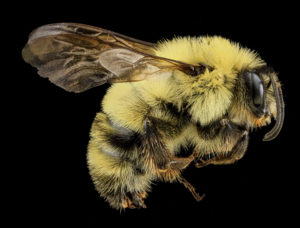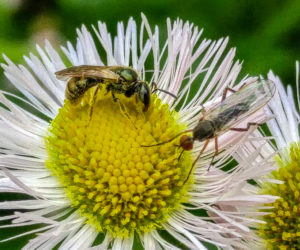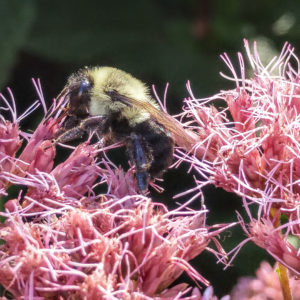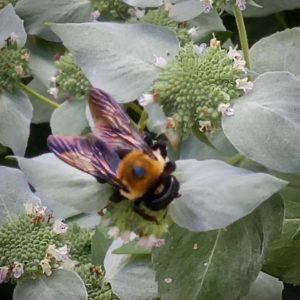Vol. 22 Issue 2, Summer 2017
by Anne Owen, Audubon at Home Ambassador


There’s quite a buzz about bees at the moment, as the long campaign for protection under the Endangered Species Act or the rusty patched bumble bee (Bombus affinus) has finally met with success. Of course, the effort to ensure the recovery of the species is only just getting underway, but the Fish and Wildlife Service listing is a very significant step that will benefit not only this species, but also all the many other pollinators that share its habitat.
There are over 450 species of bees native to the Mid-Atlantic/Northeastern United States and they are among the most important pollinators of flowering plants. Non-parasitic bees
visit flowers to find nectar and pollen, which they collect or consume for regurgitation to provide nourishment for their grubs. Most female bees collect pollen on scopae (Latin for broom), a dense mass of elongated hairs, usually on the hind leg or abdomen. Bees with scopae on their abdomen will typically land belly-first on a flower. Bumble bees and the non-native honey bee have pollen baskets or corbicula (Latin for basket), which are easily visible appendages that form a cavity that the bee sweeps pollen into . As the bees visit multiple flowers some pollen will fall off, assisting with the flower’s pollination.
Unfortunately, very few of us will be lucky enough to see the rusty patched bumble bee as bee numbers in general are in decline, along with many other pollinators, through loss of habitat, use of pesticides, and other threats. Here are some simple steps that we can take to provide food and habitat for bees (and all sorts of other critters too).
1. Plant a variety of shrubs and perennials that will provide pollen and nectar throughout the season, making your selection based on available light and moisture.
Spring: A number of spring ephemerals and early flowering shrubs are critical to various species of Specialist bees. Spring Beauty (Claytonia virginica), Trout Lily, (Erythronium americanum), and Common Violets (Viola sororia) all have their own Specialist bees, as do Redbud trees (Cercis canadensis). Generalist bees will benefit too from Golden Alexander (Zizia aurea) and Golden Ragwort (Packera aurea).
Summer: All the familiar plants that we plant for butterflies will benefit the 80% of bee species that are generalists. Favorites include Milkweeds (Asclepias sp.), Brown-eyed Susan (Rudbeckia sp.), and Bee Balms (Monarda sp.). Significant shrubs include Winterberry (Ilex verticillata) and New Jersey Tea (Ceanothus americanus).
Fall: Asters (Symphyotrichum sp.), Goldenrods (Solidago sp.), and Woodland Sunflower (Helianthus divaricatus) will provide late season sustenance.
2. Leave some “untidy places” for nest sites and over-wintering spots.
About 70% of native bees, including the charismatic bumble bees, nest underground and need undisturbed and uncompacted bare dirt.
The remaining 30% use cavities – carpenter bees may excavate new cavities, while mason bees will reuse beetle larvae holes in a snag or other small, protected cavities.
3. Leave pithy shrub and perennial stems and leaf litter undisturbed through the winter to protect cavity nesters.
4. Avoid using pesticides, especially during the months when bees are active.
5. Provide a source of water.
Resources:
With the renewed interest in native bees, there are many excellent resources available if you are interested in managing your property for bees and other Wildlife.
Loudoun Wildlife Conservancy Audubon at Home – contact Ann Garvey at agarvey@loudounwildlife.org
Xerxes Society for Invertebrate Conservation: www.XERCES.org
Heather Holm, Pollinators of Native Plants: Attract, Observe and Identify Pollinators and Beneficial Insects with Native Plants (Pollination Press, 2014)



